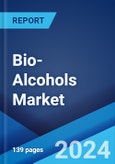The global bio-alcohols market size reached US$ 14.1 Billion in 2023. Looking forward, the publisher expects the market to reach US$ 31.6 Billion by 2032, exhibiting a growth rate (CAGR) of 9.4% during 2023-2032.
Bio-alcohols comprisebiomethanol, bioethanol, biopropanol, and biobutanol, which are renewable and eco-friendly fuels produced from biological resources or biomass. They are fermented by the action of microorganisms and enzymes through the fermentation of sugars, starches, and cellulose. They are combustible, volatile, and offer low viscosity and toxicity with a high energy density. At present, due to the emerging trend of cocktail culture, especially among millennials, bio-alcohols are gaining immense traction in alcoholic beverages.
2. What is the expected growth rate of the global bio-alcohols market during 2024-2032?
3. What are the key factors driving the global bio-alcohols market?
4. What has been the impact of COVID-19 on the global bio-alcohols market?
5. What is the breakup of the global bio-alcohols market based on the product type?
6. What is the breakup of the global bio-alcohols market based on the raw material?
7. What is the breakup of the global bio-alcohols market based on the application?
8. What are the key regions in the global bio-alcohols market?
9. Who are the key players/companies in the global bio-alcohols market?
Bio-alcohols comprisebiomethanol, bioethanol, biopropanol, and biobutanol, which are renewable and eco-friendly fuels produced from biological resources or biomass. They are fermented by the action of microorganisms and enzymes through the fermentation of sugars, starches, and cellulose. They are combustible, volatile, and offer low viscosity and toxicity with a high energy density. At present, due to the emerging trend of cocktail culture, especially among millennials, bio-alcohols are gaining immense traction in alcoholic beverages.
Bio-Alcohols Market Trends:
The increasing adoption of biofuels in automobiles due to the implementation of stringent government regulations for minimizing carbon emissions of vehicles represents one of the major factors positively influencing the demand for bio-alcohols. It can also be attributed to the risingsales of high-performance automobiles and inflating prices of petrol worldwide. In addition, it is used in construction materials as it is a biodegradable, sustainable and economicalrenewable energy resource. This, in confluence with rising construction activities in the residential, commercial, and industrial areas, is contributing to the market growth. Apart from this, bio-alcohols are widely employed in personal care and cosmetic products, such as perfumes, body mist, hair sprays, and hand sanitizers. This, along with the growing demand for organic and natural products, is propelling the market growth. Furthermore, the increasing consumer awareness abouthousehold cleanliness and hygiene is catalyzing the demand for bio-alcohols in household cleaners and disinfectants. Besides this, the widespread product usage in the production of medicinal productsis offering lucrative growth opportunities to industry investors.Key Market Segmentation:
The publisher provides an analysis of the key trends in each sub-segment of the global bio-alcohols market report, along with forecasts at the global, regional and country level from 2024-2032. The report has categorized the market based on product type, raw material and application.Breakup by Product Type:
- Bio-Methanol
- Bio-Ethanol
- Bio-Butanol
- Bio-BDO
- Others
Breakup by Raw Material:
- Grains
- Sugarcane
- Industrial Beets
- Biowaste
- Others
Breakup by Application:
- Transportation
- Construction
- Medical
- Power Generation
- Others
Breakup by Region:
- North America
- United States
- Canada
- Asia Pacific
- China
- Japan
- India
- South Korea
- Australia
- Indonesia
- Others
- Europe
- Germany
- France
- United Kingdom
- Italy
- Spain
- Russia
- Others
- Latin America
- Brazil
- Mexico
- Others
- Middle East and Africa
Competitive Landscape:
The competitive landscape of the market has been analyzed in the report, along with the detailed profiles of the major players operating in the industry. Some of these players are BASF SE, Braskem SA, Cargill, Incorporated, DuPont de Nemours, Inc., Fulcrum BioEnergy, Inc., Genomatica, Inc., Harvest Power, Koninklijke DSM N.V., Lallemand Inc., Mitsubishi Chemical Holdings Corporation, PTT Global Chemical Public Company Limited, and Valero Marketing and Supply Company.Key Questions Answered in This Report
1. How big is the global bio-alcohols market?2. What is the expected growth rate of the global bio-alcohols market during 2024-2032?
3. What are the key factors driving the global bio-alcohols market?
4. What has been the impact of COVID-19 on the global bio-alcohols market?
5. What is the breakup of the global bio-alcohols market based on the product type?
6. What is the breakup of the global bio-alcohols market based on the raw material?
7. What is the breakup of the global bio-alcohols market based on the application?
8. What are the key regions in the global bio-alcohols market?
9. Who are the key players/companies in the global bio-alcohols market?
Table of Contents
1 Preface3 Executive Summary11 Value Chain Analysis13 Price Analysis
2 Scope and Methodology
4 Introduction
5 Global Bio-Alcohols Market
6 Market Breakup by Product Type
7 Market Breakup by Raw Material
8 Market Breakup by Application
9 Market Breakup by Region
10 SWOT Analysis
12 Porters Five Forces Analysis
14 Competitive Landscape
List of Figures
List of Tables
Companies Mentioned
- BASF SE
- Braskem SA
- Cargill Incorporated
- DuPont de Nemours Inc.
- Fulcrum BioEnergy Inc.
- Genomatica Inc.
- Harvest Power
- Koninklijke DSM N.V.
- Lallemand Inc.
- Mitsubishi Chemical Holdings Corporation
- PTT Global Chemical Public Company Limited
- Valero Marketing and Supply Company
Methodology

LOADING...
Table Information
| Report Attribute | Details |
|---|---|
| No. of Pages | 139 |
| Published | March 2024 |
| Forecast Period | 2023 - 2032 |
| Estimated Market Value ( US$ | US$ 14.1 Billion |
| Forecasted Market Value ( US$ | US$ 31.6 Billion |
| Compound Annual Growth Rate | 9.4% |
| Regions Covered | Global |
| No. of Companies Mentioned | 12 |









